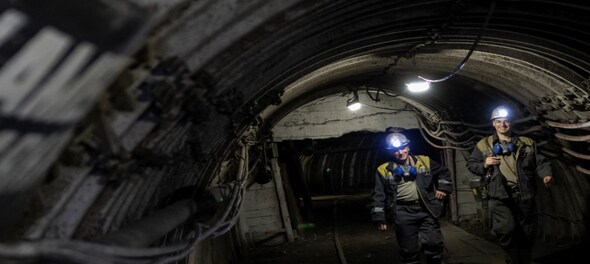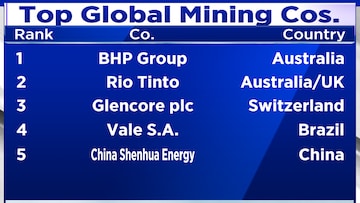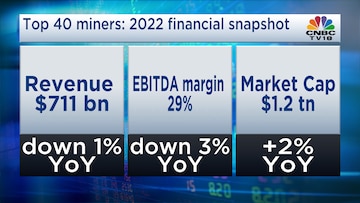
In the past 20 years, the market capitalisation of the top 40 mining companies has more than tripled from $387 billion in 2003 to $1,225 billion in 2022, mainly due to consolidation. Of the top 40 miners, more than one-third have merged with other players through a series of huge, sector altering transactions. The good news is that more mega deals are expected in the coming years, according to a report by PwC.
There is an emergence of new technology for remote and automated work, something that mining CEOs said was 'unheard of' in the industry only a few years prior. Covid accelerated this trend of forcing miners to adopt technology so as to operate safely.

Geopolitical uncertainty creates fears for sourcing of critical minerals
With concerns about the supply shortfalls that could occur amid booming demand, there is an emergence of critical minerals bringing opportunities for miners. National governments have moved to secure access to copper, lithium and other critical minerals through alliances or new trade deals. Reconfiguring existing supply chains will require enormous amount of fresh capital and cause supply chain disruptions with price volatility. One of the recent agreements is between US and Japan signed in March 2023. This trade deal on battery minerals like lithium, nickel, cobalt, graphite and manganese is meant to help Japanese automakers.
In recent past, many countries have introduced legislation addressing critical minerals production, processing and manufacturing. With approximately $370 billion in spending and tax credits to support clean energy industries, the US Inflation Reduction Act (IRA) significantly increases the volume of public capital available for critical minerals investments. The IRA presents vast opportunities for big mining companies. Though miners cannot physically shift their mines to US, they can make changes to their operating processes, investment plans, processing routes and workforces to capitalise on the IRA's incentives.
Tackling climate change
Mining processes account for 4 to 7 percent of global greenhouse gas emissions. Reducing carbon emissions helps avoid risks such as market barriers, fines and loss of social license to operate along with cost savings and favorable financing terms. However, mineral buyers are largely unwilling to pay a premium price for products made with comparatively low carbon emissions. But government legislation is creating new financial incentives as well as penalties to achieve carbon reduction. For example, European Union has introduced a border tariff on imports of carbon intensive goods like aluminum, steel, iron. Legislations like these force companies to meet carbon standards if they want to compete in a given market.
Some of the cost efficient measures to decarbonise are direct electrification, efficiency improvement and renewable energy. For example, Chilean coper miner Codelco is reducing emissions by 15,000 tonnes of carbon dioxide and saving $2 million per year using solar power.
Decarbonisation with reduced fossil fuels usage
According to the IEA, coal fired power generation increased in 2022 amid a global energy crisis, which suggests the struggle to achieve a steady reduction in usage of fossil fuels. IEA forecasts global coal fired power generation to level off from 2023 to 2025, with increases in Asia-Pacific. This implies a continued need for thermal coal until alternative energy sources are reliably embedded in the global energy grid.
Financial analysis hints at uncertainty ahead
In 2022, top 40 mining companies reported strong revenues of $711 billion, with revenues remaining near the high point of 2021. However, softening commodity prices and rising opportunity costs hurt cash flow and margins.
For the first time since 2010, coal was the largest contributor to total revenue rising from 23 percent to 28 percent, largely price driven, with average spot prices doubling across the year. Copper revenue remained largely the same with increasing volumes offset by a decrease in price. Iron ore saw declining volumes and prices, as economic uncertainty and covid restrictions across China pushed down global steel demand.

Exploration
Total exploration spending is expected to decline in 2023 as earnings soften, though smaller exploration budgets could exacerbate shortages of critical minerals.
Outlook for 2023
Softening prices for many key commodities may result in 9 percent fall in revenues for the top 40 mining companies globally, according to a report by PwC. Revenue from coal is expected to fall by at least 20 percent. Further, lower shipping and fuel costs will offset inflation pressures. EBITDA margins are expected to decline to 28 percent in 2023 from 29 percent in 2022 and head towards a negative cash flow. Payment of dividends are expected to be still high, although down from 2022 levels.
Check out our in-depth Market Coverage, Business News & get real-time Stock Market Updates on CNBC-TV18. Also, Watch our channels CNBC-TV18, CNBC Awaaz and CNBC Bajar Live on-the-go!


Election Commission grants shifting of 7 polling stations in Kullu, Mandi, Shimla and Kinnaur
May 5, 2024 6:50 PM
Tents, fans, ambulances – Karnataka gears up for voting on May 7 amid soaring heat
May 5, 2024 6:19 PM
Karnataka Congress files complaint against BJP’s JP Nadda and others over alleged MCC violation
May 5, 2024 3:20 PM
PM Modi to contest from Varanasi, to file nomination papers on May 14
May 5, 2024 2:49 PM

